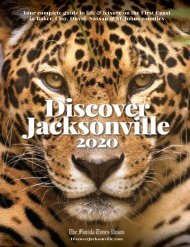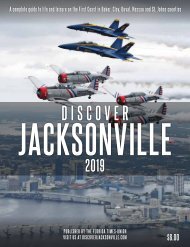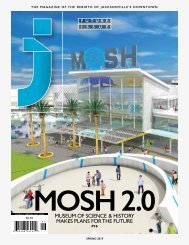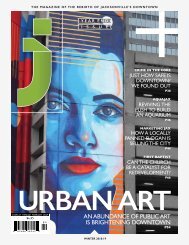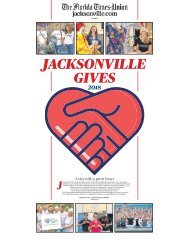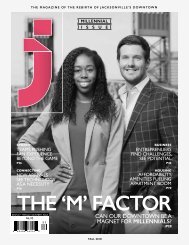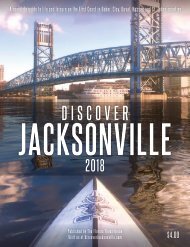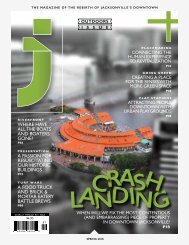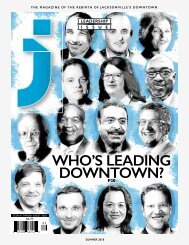J Magazine Winter 2019
You also want an ePaper? Increase the reach of your titles
YUMPU automatically turns print PDFs into web optimized ePapers that Google loves.
To ride in the core city, a cyclist “needs to be annoying and not a lot<br />
of people are willing to do it,” Mayhew said. “On the one-way streets<br />
you have to be brave enough to ride in the traffic lane, in the middle.”<br />
Though legal, cycling on a sidewalk is not advisable, Mayhew said.<br />
Not only are there pedestrians to avoid, sidewalks are often intersected<br />
by driveways in places drivers aren’t expecting cyclists.<br />
“People on the roads yell at you to get on the sidewalk, and people<br />
on the sidewalk tell you to get in the road,” Mayhew said.<br />
There needs to be accommodations made for cyclists – sharrows<br />
(roads shared by vehicles and bikes), bike lanes and preferably bike<br />
paths separated from traffic, he said.<br />
“It all boils down to political will and money,” Mayhew said. “You<br />
can find the money, but will the city do it?”<br />
The answer is yes.<br />
Redevelopment plans for Downtown include making the area<br />
friendlier to walkers and cyclists by converting several one-way streets<br />
to two-ways and adding dedicated bike lanes separated from vehicular<br />
traffic by medians, said Lori Boyer, CEO of the Downtown Investment<br />
Authority.<br />
The projects are in various stages of implementation.<br />
Hogan Street will be converted to a two-way street with a two-way<br />
bike lane, giving cyclists a corridor between a new riverfront park on<br />
the Northbank called Hogan Street Plaza, Hemming Plaza and north<br />
to Florida State College at Jacksonville. It is in the Capital Improvement<br />
Plan for 2021/22.<br />
Liberty Street also will have protected bike lanes.<br />
Dedicated bike lanes are also under consideration for the Bay<br />
Street Innovation Corridor, Laura Street, Church Street and Riverside<br />
Avenue.<br />
Park Street will undergo a road diet from Forest Street to Stonewall<br />
Street, reducing the number of traffic lanes from four to three to slow<br />
down traffic and adding a two-way bicycle track that will go to Interstate<br />
95. That project is funded and in the design phase.<br />
Lee Street will have a dedicated bike lane connecting Park Street<br />
to the Emerald Trail. The project is funded and in the design phase.<br />
“This will build out a network,” Boyer said. “It’s not every street,<br />
but a network every few blocks with clearly dedicated lanes, not just<br />
striped lanes. If you can cut<br />
across Liberty, Hogan and Lee,<br />
that gives you the ability to go all<br />
directions.”<br />
A dedicated bike lane is also<br />
part of the road diet work nearing<br />
completion on Riverplace<br />
Boulevard on the Southbank.<br />
And, Laura Santana, director<br />
of transportation planning, said<br />
the city is considering a road diet<br />
for Prudential Drive from Riverplace<br />
Boulevard to the District<br />
that would include bike lanes.<br />
By the end of 2020, cyclists<br />
and walkers will be able to cross<br />
the Fuller Warren Bridge on a<br />
multi-use bike path that will<br />
connect the Northbank and Southbank Riverwalks. The multi-use<br />
path will continue in front of Nemours Children’s Clinic and eventually<br />
stretch to the District via Nira Street.<br />
Other bicycle-friendly features are part of the city’s Transportation<br />
Mobility Plan, which is expected to go to the City Council in the<br />
spring. The plan includes funding for projects through a mobility fee<br />
paid by developers.<br />
“I get a lot of close calls. In<br />
the mornings, people are going<br />
for donuts. Afternoons are<br />
even worse. Everyone is on<br />
their phone. You really have to<br />
be on your toes.”<br />
TROY MAYHEW, Downtown cyclist<br />
Boyer said she is “aggressively pursuing” a plan to create more<br />
two-way streets in Downtown to slow down traffic and create an ambiance<br />
that is friendlier to residential and retail.<br />
But there will still be a network of one-way streets — Main and<br />
Ocean, Broad and Jefferson, and State and Union — to move traffic<br />
through Downtown.<br />
“But inside that box, we want to have a neighborhood like any<br />
other,” Boyer said. “Every street doesn’t need to be a highway. If we’re<br />
going to have residents out walking, we need to slow down traffic and<br />
provide shade and restaurants. This is not just about traffic, it’s about<br />
economic development.”<br />
Burns said he is looking forward to the day when Downtown has<br />
dedicated bike lanes.<br />
“The Master Plan has great ideas and over 200 projects. The problem<br />
is implementing the plan,” Burns said. “We can’t have a plan that<br />
sits on the shelf, and great projects that don’t get funded. If we just<br />
do one or two a year, it’ll take 100 years to enact the plan. We have to<br />
be committed to building these projects and not just pay lip service.”<br />
But Santana said it’s not enough to build bike friendly infrastructure,<br />
incorporating cycling Downtown will take a cultural shift.<br />
“We have to learn to respect different modes of transportation. We<br />
have to teach drivers to be respectful of vulnerable users like pedestrians<br />
and cyclists. And we have to teach pedestrians and cyclists to be<br />
careful around drivers,” Santana said.<br />
“When you walk around Charleston, if you walk into the street, the<br />
cars just stop, but here they beep at you,” Santana said. “That’s going<br />
to take a long time to change.”<br />
The city has implemented what it calls the 5 E’s: education, encouragement,<br />
enforcement, evaluation and engineering.<br />
The education component created an awareness campaign with<br />
promotional and social media ads to educate people how to safely<br />
walk and cycle. The program also includes free bicycle helmet fittings.<br />
The encouragement component focuses on the reasons like health<br />
for people to walk and bike in the city.<br />
The enforcement component involves Jacksonville Sheriff’s Office<br />
issuing warnings and tickets to reduce negative behavior.<br />
The evaluation component analyzes the statistics of accidents and<br />
fatalities and their causes.<br />
And, the engineering component<br />
is about building the<br />
infrastructure to make walking<br />
and cycling safer.<br />
“Jacksonville can definitely<br />
be a biking city,” Dwyer said.<br />
“The urban core is structured so<br />
it can be bikeable and walkable.<br />
All it would take is a change of<br />
direction in what we fund. We<br />
could be up in the top 10 of bike<br />
friendly cities or places where<br />
you can live without a car.<br />
“If the city signals to people<br />
that we are prioritizing bikers<br />
and walkers, they will come to<br />
expect it,” Dwyer said. “If we<br />
want Downtown to grow and be vibrant, we want to be able to share<br />
this space with people of all ages, races and modes of transportation.<br />
We need to make it a city where children can ride their bikes<br />
Downtown.”<br />
Lilla Ross, a former news editor at the Florida Times-Union,<br />
lives in San Marco.<br />
WINTER <strong>2019</strong> | J MAGAZINE 43



